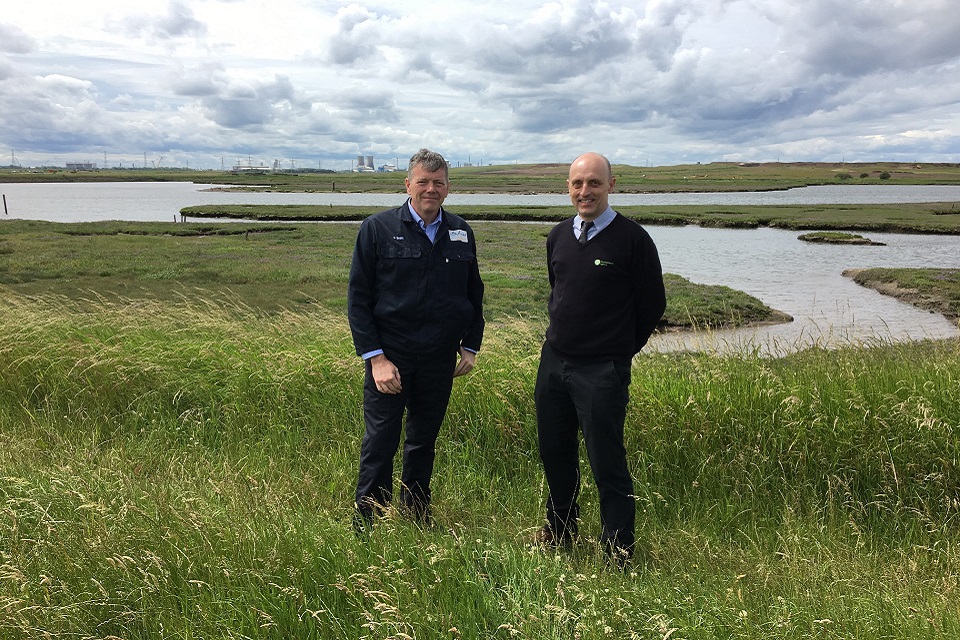Press release: Work starts on £11million North East flood scheme
The Environment Agency has joined forces with local businesses to reduce the risk of flooding to the community and give wildlife a boost in Teesside.
Work has started on the £11million project, which will increase flood protection from Greatham Creek while creating around 30 hectares of extra habitat.
The Environment Agency is working with local businesses in the area with SABIC UK providing funding towards the scheme and INOVYN ChlorVinyls providing some of their land for the additional habitat creation.
And they are working closely with partners at RSPB and Natural England to design and build a scheme which maximises benefits for the internationally designated habitat, and to ensure disruption to wildlife and visitors to the local area is kept to a minimum.
New habitat creation
The first phase of the project, which saw new flood defences built at Port Clarence to reduce flood risk from the River Tees at a cost of £4.5million, was finished in December 2015.
Phase two will see the Environment Agency raise existing flood embankments along Greatham Creek, to reduce the flood risk to Port Clarence and land which is south of the Creek.
There will also be a managed realignment of part of the current flood defences. This means a new embankment to the north of RSPB Saltholme Nature Reserve will be built around a larger area of land, and then the existing flood embankment will be breached.
This results in the creation of around 30 hectares of intertidal habitat to the north of the nature reserve. It’s a popular area frequented by seals, and a variety of bird species including shelduck, knot and redshank.

Phase 2 is expected to be complete by the end of 2018. Together the projects reduce the risk of flooding from both the River Tees and Greatham Creek at Port Clarence, protecting 350 homes and 32 businesses.
‘Vastly improving existing defences’
The Environment Agency’s Senior Advisor on the scheme Phil Marshall said:
I remember well the devastating impact the tidal surge in December 2013 had on the area, affecting around 50 homes and businesses.
By working together with local industry we’re vastly improving existing defences to protect residents and businesses and reduce the risk of flooding now and into the future as sea levels start to rise.
It’s a great example of how we’re working closely with partners, businesses and communities to create long-term, sustainable solutions to flooding while also making enhancements to the environment.
This is a vital conservation area enjoyed by visitors from far and wide and we’re taking the opportunity to create 30 hectares of extra habitat to ensure wildlife continues to thrive.
In addition, while access to the creek is limited during the work, we are working with RSPB Saltholme to enable visitors to see live images from the creek of the ever popular seals.

Working in partnership
Daren Smith, SABIC Site Director (acting) added:
As a responsible company, SABIC take the protection of our environment and our communities extremely seriously. Our own land was devastated by the flood but our employees worked extremely hard and quickly with local agencies to rebuild some of the natural habitats that exist there.
SABIC are delighted to be working in partnership with the Environment Agency and other agencies to enable this vital sustainable project to be delivered.
Contractors BMMJV (BAM Nuttall and Mott MacDonald Joint Venture), are carrying out the work on behalf of the Environment Agency.
Phase 1 of the scheme saw new flood defences built in Port Clarence, consisting of a mixture of earth embankments, flood walls, and a raised section of the road on the approach to the Transporter Bridge.
In addition, the Environment Agency worked together with local business Wilton Engineering to install removable steel flood defences along the River Tees to improve flood protection while still allowing Wilton to operate from the river.
If you would like to know more about your risk of flooding and how to be prepared call Floodline on 0345 988 1188, or visit www.gov.uk/flood